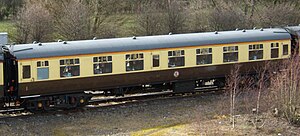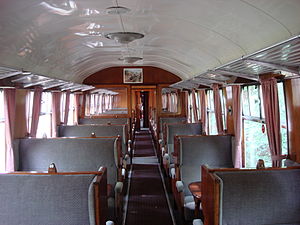This article needs additional citations for verification. (June 2010) |
| British Rail Mark 1 | |
|---|---|
 Mark 1 Open First on Commonwealth bogies at Tyne Yard in March 2009 | |
 Interior of a Mark 1 SO (Second Open) Colne Valley Railway | |
| In service | 1951–present |
| Manufacturer | British Railways Cravens Gloucester Railway Carriage & Wagon Company |
| Built at | Derby Doncaster Eastleigh Swindon Wolverton York |
| Constructed | 1951–1963 |
| Operators | British Railways |
| Specifications | |
| Car body construction | Steel Body-on-frame, non-integral |
| Car length | 57 ft 0 in (17.37 m) or 63 ft 6 in (19.35 m) |
| Doors | Slam |
| Maximum speed | 90 or 100 mph 140 or 160 km/h |
| HVAC | Steam or electric or both |
| Bogies | BR1, BR2, Commonwealth or B4 |
| Braking system(s) | automatic vacuum, air, or dual |
| Coupling system | Drawhook or retractable knuckle coupler resting on drawhook |
| Track gauge | 4 ft 8+1⁄2 in (1,435 mm) standard gauge |

British Rail Mark 1 is the family designation for the first standardised designs of railway carriages built by British Railways (BR) from 1951 until 1974, now used only for charter services on the main lines or on preserved railways.
Following nationalisation in 1948, BR had continued to build carriages to the designs of the "Big Four" companies (the Great Western, Southern, London, Midland and Scottish and London and North Eastern railways), and the Mark 1 was intended to be the standard carriage design for use across all lines, incorporating the best features of each of the former companies' designs. It was also designed to be much stronger than previous designs, to provide better protection for passengers in the event of a collision or derailment.
The Mark 1 coaches were built in two distinct tranches: the early vehicles (1951–1960) and, from 1961 onwards, the "Commonwealth" stock – so named on account of their bogies, which were a variant of the bogie designed by the General Steel Castings Corporation (formerly named the Commonwealth Steel Company) of Granite City, United States of America.